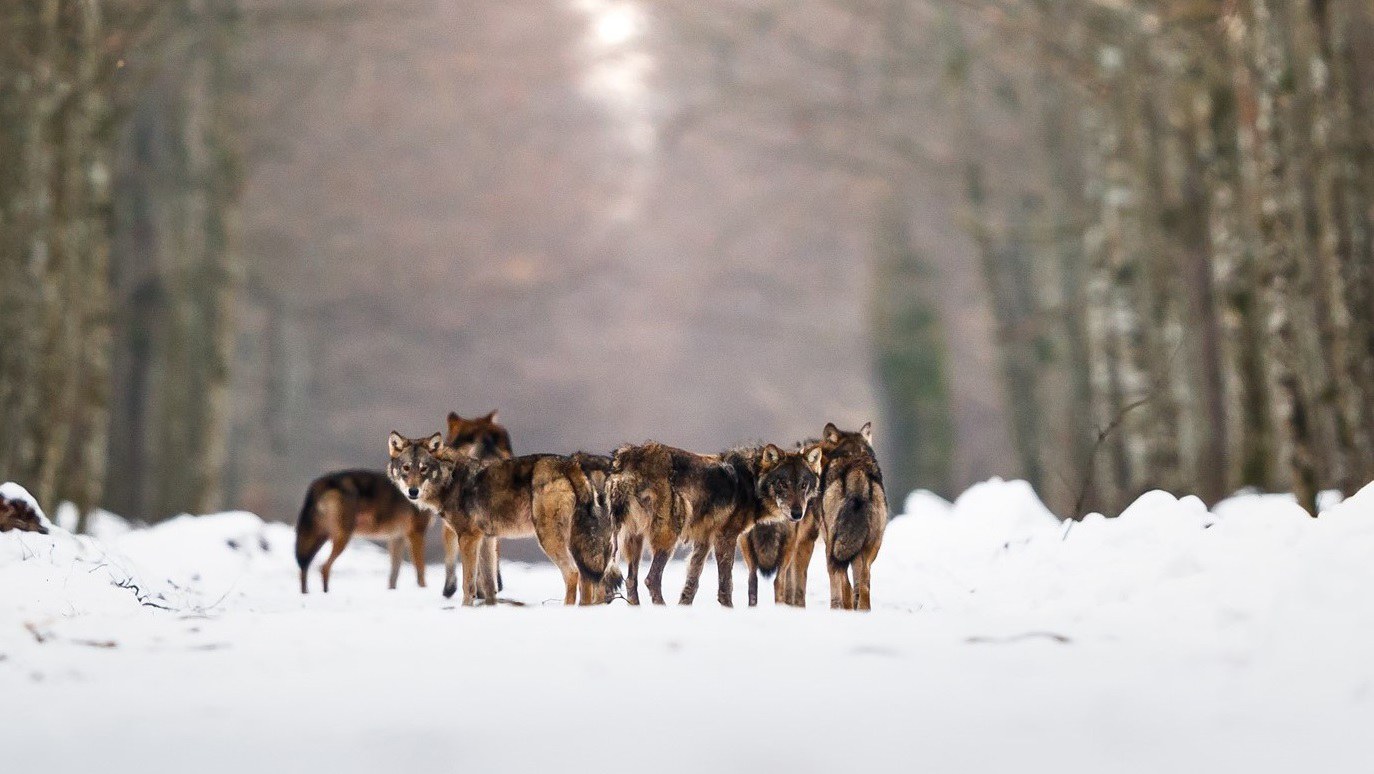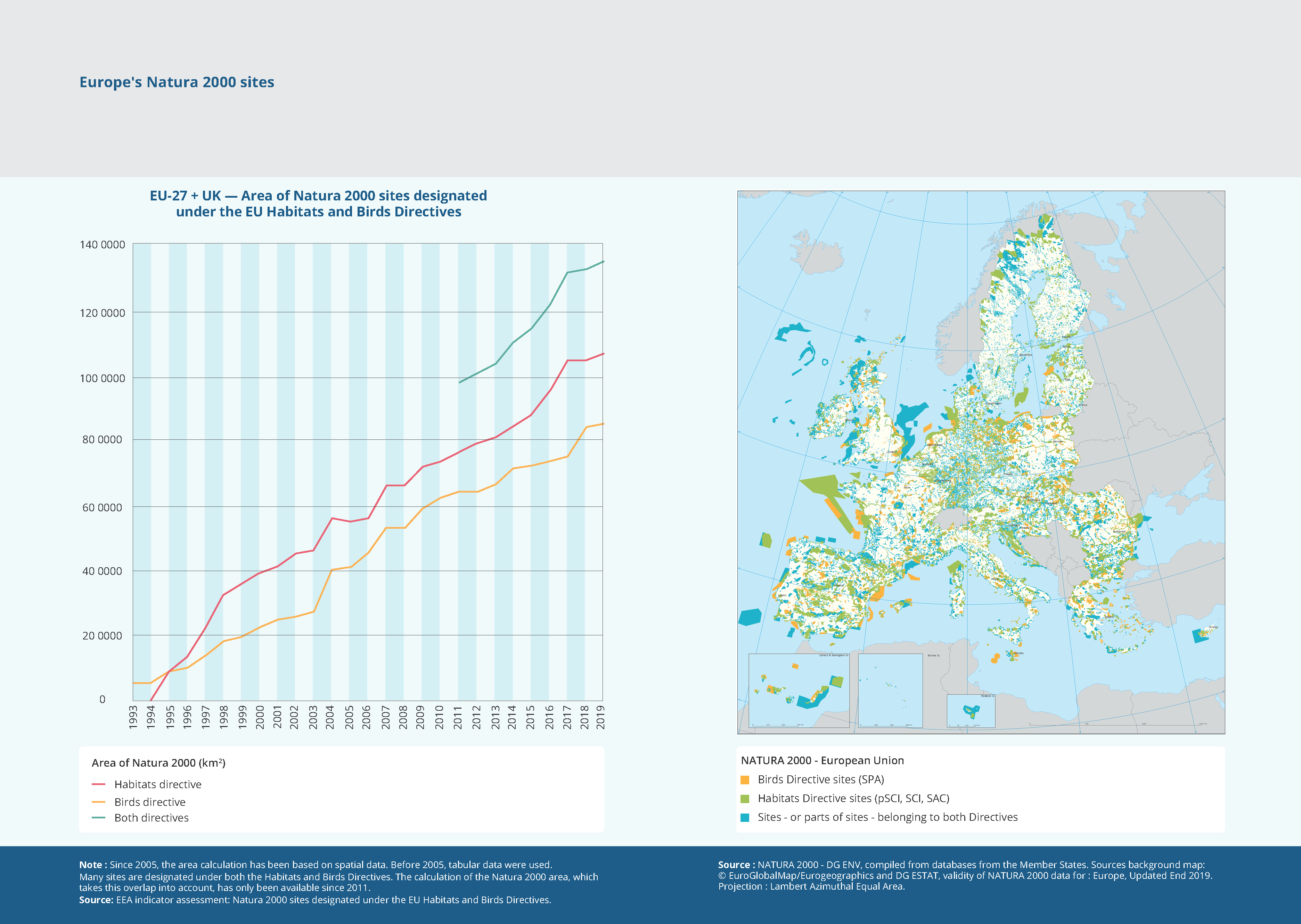Protecting nature is the first step. Biodiversity in Europe continues to decline but there have recently been positive developments for forests, mammals and birds, which are benefiting from conservation measures.
Currently, conservation efforts for more than 2 000 species are covered by EU legislation such as the Birds and the Habitats Directives. At the heart of these directives is the EU’s Natura 2000 network of protected areas, the largest of its kind in the world. It makes up 18 % of the EU’s land area and 8 % of its marine territory.
Some of the most valuable and threatened species and habitats in Europe are protected by Natura 2000. Protected sites contain breeding and resting places for rare and threatened species, while some rare habitats are designated as sites in themselves.

The target of the new EU biodiversity strategy is to increase the protected area to at least 30 % of EU land and 30 % of surrounding seas by 2030. Primary and old-growth forests and other carbon-rich ecosystems, such as peatlands and grasslands, will be the focus of conservation efforts.
© Mateusz Piesiak, REDISCOVER Nature /EEA,
Moreover, the strategy calls for planting at least 3 billion trees by 2030 to support biodiversity and ecosystem restoration. More forests will also be managed to promote biodiversity-friendly practices.
Joining the dots
Developing the Trans-European Nature Network by enlarging protected areas to meet the 30 % target is part of the biodiversity strategy. Many Natura 2000 protected areas are already connected by natural and semi-natural landscapes that provide ecosystem services, such as pollination, soil fertility, flood control and recreation, and are essential for climate change mitigation and disaster risk. The Emerald Network of Areas of Special Interest, to which the EU contributes via Natura 2000, also supports the same efforts. Together, these areas form a green infrastructure network across Europe. Studies suggest that nature is better protected inside this network, which contains a greater area providing the required services and experiencing fewer ecosystem pressures.
However, barriers such as roads, railways, urban areas and agricultural land fragment the landscape, limiting the movement of species and hindering the network’s development. Increasing the connectivity of the network helps ensure that habitat conditions are improved, biodiversity decline is prevented and ecosystem service delivery is boosted.
Free-flowing water
Barriers hinder the health of Europe’s water bodies. There are over 1 million barriers on European rivers, including dams, weirs and sluices. Most are small and obsolete. They contribute greatly to the poor state of nature in our rivers, as many species require rivers to be free-flowing to thrive and currently the movement downstream of sediment is prevented, causing blockages and altering habitats.
The biodiversity strategy aims to restore at least 25 000 km of free-flowing rivers by 2030 by removing barriers, constructing bypasses for migrating fish and re-establishing the flow of sediment. By October 2020, almost 5 000 dam removals had been recorded in Europe, based on data from 11 countries. Restoring floodplains and wetlands is also an important element of this work.
Call of the wild
While the above solutions require intensively managed processes to restore nature, rewilding is a newer, more natural approach. By identifying spaces where natural processes are encouraged, it allows nature to heal so that it can start to manage on its own again. Initiatives such as Rewilding Europe are working to increase Europe’s biodiversity in this way.
Today there are eight large rewilding areas in Bulgaria, Croatia, Germany, Italy, Poland, Portugal, Romania and Sweden. These are home to various rewilding projects including the re-establishment of free-roaming populations of European bison in Romania’s Southern Carpathians and the protection of the black and griffon vultures in the Rhodope mountains in Bulgaria.
Europe’s nature overseas
The EU’s outermost regions and overseas countries and territories cover about the same land area as the EU and the world’s largest marine territories.
The EU’s more than 150 overseas islands host more than 20 % of the world’s coral reefs and lagoons and have a very rich biodiversity. However, these island ecosystems are also highly vulnerable to invasive species, human activities and climate change impacts.
The BEST initiative — biodiversity and ecosystem services in territories of European overseas — aims to support the conservation of biodiversity and sustainable use of ecosystem services in the EU outermost regions and overseas countries and territories. Currently, BEST projects support conservation efforts in EU territories around the world, from the Amazonia and Caribbean regions to the Macaronesia and Polar regions.
Changing human-made systems
The EEA’s landmark assessment of the state of Europe’s environment showed that, in addition to conservation measures, we need to fundamentally change the way we produce and consume food and energy, how we develop and experience the cities we live in and how we move people and goods around.
Agricultural activities and other land management practices exert the greatest pressure on nature, with the abandonment of grasslands having a particularly big impact on pollinators, farmland birds and semi-natural habitats. By increasing organic farming by a quarter, reducing pesticide use by half by 2030 and restoring some agricultural land to high-diversity landscapes, we will help restore biodiversity.
Urban green spaces have been used more than ever during the COVID-19 pandemic. Protection of such spaces is increasing, but grey infrastructure still often dominates as urban populations grow. The biodiversity strategy calls on citizens to develop urban greening plans, and to create and connect urban parks, gardens, meadows and farms, as well as install green roofs and walls, and line streets with trees and hedges to allow biodiversity to return. Plans should also aim to eliminate pesticides and, for example, establish pollinator-friendly areas in cities.
Finally, the European Commission has presented a zero pollution action plan, Towards zero pollution for air, water and soil. Goals include a 50 % reduction in nutrient loss by reducing the run-off of nitrogen and phosphorus from fertilisers, while protecting soil fertility. In addition, the farm to fork strategy for a fair, healthy and environmentally friendly food system will also reduce the use of pesticides.

Note: Since 2005, the area calculation has been based on spatial data. Before 2005, tabular data were used. Many sites are designated under both the Habitats and Birds Directives. The calculation of the Natura 2000 area, which takes this overlap into account, has only been available since 2011.
Chart source: EEA indicator assessment: Natura 2000 sites designated under the EU Habitats and Birds Directives.
Map source: NATURA 2000 - DG ENV, compiled from databases from the Member States. Sources background map: © EuroGlobalMap/Eurogeographics and DG ESTAT, vallidity of NATURA 2000 data for : Europe, Updated End 2019. Projection : Lambert Azimuthai Equal Area.

Document Actions
Share with others